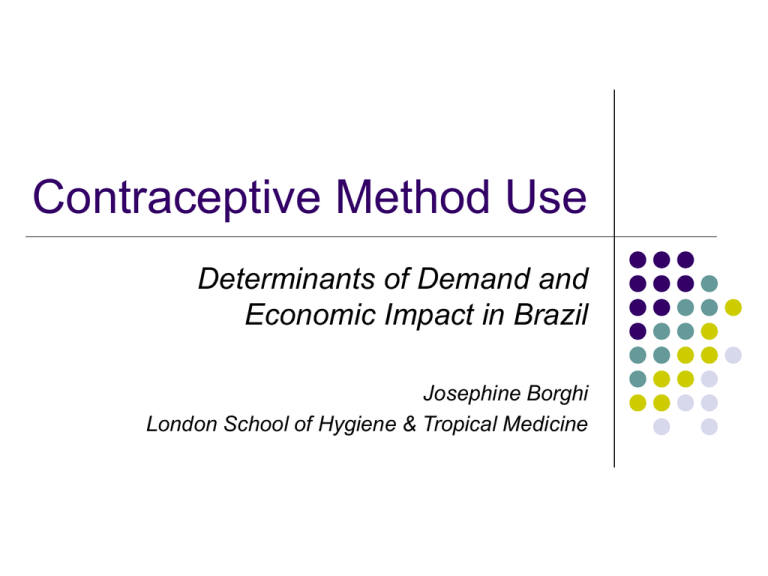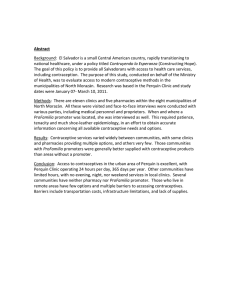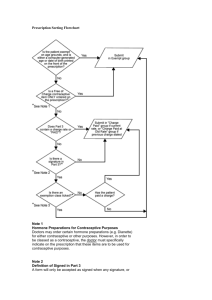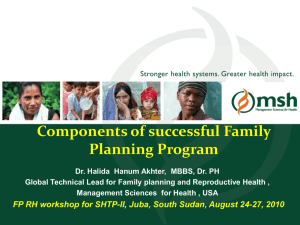Contraceptive Method Use Determinants of Demand and Economic Impact in Brazil Josephine Borghi
advertisement

Contraceptive Method Use Determinants of Demand and Economic Impact in Brazil Josephine Borghi London School of Hygiene & Tropical Medicine Overview Contraceptive demand – global perspective Contraceptive demand in Brazil Economics of contraceptive demand Research aim and objectives Setting Methods Contraceptive demand and global priorities ICPD, 1994: universal access to sexual and reproductive health by 2015 120 m couples unmet need 80 m unwanted pregnancies 19 m unsafe abortions – 30% of maternal deaths Percent coverage Contraceptive Coverage – Regional Patterns 100 90 80 70 60 50 40 30 20 10 0 Traditional method Other Modern method Condom Pill Female sterilization Europe North America Africa Asia Latin America & Carribean Regions Source: UN (2005) World Contraceptive Use - 2005 Annual Incidence of Abortion per 100 Live Births WHO (2000 data) Contraceptive Use - Brazil •High level of contraceptive prevalence (77%) Female sterilization Pill 24% 40% 6% 5% Condom Other Modern method 21% 4% Source: Last DHS (1996) Traditional method None Female Sterilization in Brazil Rationale Method security Convenience Limited access to alternative methods Limited provider knowledge of alternatives Avoid costs of childbearing / contraceptives Illegal pre-1996 unless for health reasons Sterilization and c-section 60-80% carried out during c-section (Berquo, 1993) Cost 61% had to pay for the service (Vieria, 1994) Regret Average age 28 years Limited counselling Abortion in Brazil Legality Frequency 2 abortions per year per 100 women of RA Health system impact 1.7% of hospital admissions due to unsafe abortion Economics of contraceptive demand: what is known? Qualitative assessment of barriers to access Analysis of contraceptive demand based on observed behaviour – Africa and Asia User knowledge and use patterns (KAP) The costs of providing family planning services Knowledge Gaps Preferences between temporary and permanent methods Impact of product characteristics and supply context on demand Limitations of revealed preferences Provider incentives User costs Macro impact Research Question What are: The determinants of contraceptive preferences product characteristics and supply side factors; and The economic impact of current patterns of contraceptive use in Brazil and impact of possible changes? Key Questions How do individuals make choices about contraceptive methods? What motivates providers to deliver contraceptives, and how do they stand to benefit? How do current patterns of contraceptive use impact the economy of the household, the health system and the country as a whole? Setting - Bahia 4th most populous state 62% mixed race 23% illiteracy (12% national average) 45 per 1000 IMR (35 per 100 national average) 41% below poverty line Northeast region 62% contraceptive prevalence Study Sites - Background Salvador Pau de Lima 48,641 inhabitants 45% earn less than $90 per month Fiocruz cohort study Barra district Monte Santo Illiteracy 40% Largely rural IMR 61 per 1000 Study Methods - Overview Literature Review Discrete choice survey Household cost survey Provider survey Macro-economic model Literature Review Demand, preferences, access to contraceptives in low and middle income countries Economic or non-health effects of contraceptive use Discrete Choice Survey Aims Measure preferences for contraceptives Measure key attributes of value Methods Focus groups and piloting Stratified sample 1500 women (un-sterilized) (urban and rural; high and low income) Sub sample of 150 husbands Scenarios Contraceptive choices Possible characteristics Condom, IUD, pill, sterilization, abortion; current method Price, duration of protection, distance to access, place of delivery, efficacy, mode of administration, time of administration, risks; provider knowledge Possible levels Mode of administration Manual; operative; Duration of protection Per sex act; per trimester; permanent. Place of delivery Hospital; health centre; drug store Time of administration Before conception; after conception Household Costs of Abortion Aims Estimate the household costs of abortion and treatment of complications Have these displaced other expenditures? Methods Purposive sample of 150 women after treatment from post abortion (surgical or medical) complications, urban, rural Identified from hospital records (public and private) Household Costs of Sterilization Aims Estimate the household costs of tubal ligation Have these costs displaced other expenditures? Relationship, if any, to c-section? Methods Purposive sample of 150 women, urban, rural Hospital records Provider Survey Aims Estimate costs of treating abortion complications Estimate costs of tubal ligation Assess provider incentives for offering different contraceptives Methods Survey of 2 public and 2 private hospitals in Salvador and Monte Santo (recurrent costs) Purposive sample of health care providers from obstetrics wards Macro-economic model CGE model Simple, closed economy, static competitive equilibrium Selected sectors of Brazilian economy Data sources CEBRAP 2007 DHS SUS info on incidence of abortion complications in hospitals IGS input-output data – 2000 Household & provider survey data Macro-economic effects Unsafe abortion Tubal ligation Labour supply, productivity Consumption effects (households and providers) Costs to health system Financial benefits to health workers Fertility; HIV –AIDS, STI impact C-section rate Financial benefits to health workers Consumption effects Temporary methods Lower levels of fertility Increased revenue of pharmaceutical companies Risks Unsure what proportion of abortions are medical (could be high, meaning low no. of hospitalized cases for complications) Sterilization rate may have fallen Maybe limited to no user costs of abortion or tubal ligatio Sensitivity – obtaining accurate information Sample selection issues Finding respondents (timing)






